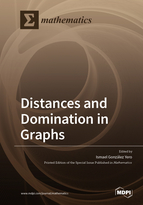Distances and Domination in Graphs
A special issue of Mathematics (ISSN 2227-7390). This special issue belongs to the section "Mathematics and Computer Science".
Deadline for manuscript submissions: closed (30 June 2020) | Viewed by 29365
Special Issue Editor
Interests: graph theory; discrete mathematics; combinatorics; metric graph theory; domination in graphs
Special Issues, Collections and Topics in MDPI journals
Special Issue Information
Dear Colleagues,
A large number of parameters related to distances in graphs have been studied in previous investigations. The most typical and known ones are perhaps the diameter, the radius, and the eccentricity. However, there are a lot number of other interesting distance-related parameters in graphs that are frequently used in applied and/or theoretical investigations. Some of the most common ones are related to well-known indexes that measure the properties of graphs, for example, the centrality, the closeness, and the betweenness centrality. One interesting fact that allows to deal with such problems is that the matrix of distances in a graph can be computed in polynomial time using, for example, the well-known Floyd–Warshall algorithm. Another interesting case in problems concerning distances in graphs is the degree-diameter problem, which basically involves the determination of the largest possible graph (in terms of the size of its vertex set) such that the largest degree of any of the vertices in the graph is, at most, the specified diameter. This problem has been extensively studied, and there is a huge body of literature on it. Some other examples of distance related parameters are the convexity number, the geodetic number, or the metric dimension.
During the last thirty years, with the increase in investigations in several areas like computer science, computer engineering, operational research, and social networks, graph theory has become an important tool for researching many of the mentioned areas. One of the most important topics in graph theory is the theory of domination and related problems such as independence, covering, and matching. The growth of studies about domination in graphs can be partly attributed to its application in diverse theoretical fields such as linear algebra, communication networks, social sciences, computational complexity, and algorithm design. The significant increase in interest in this topic has resulted in an enormous quantity of published papers—around 1600 papers, a significant number of monographs and theses, and several books.
Based on this increased interest, I invite authors to submit relevant contributions to a Special Interest of Mathematics titled “Distance and Domination in Graphs”.
Prof. Ismael González Yero
Guest Editor
Manuscript Submission Information
Manuscripts should be submitted online at www.mdpi.com by registering and logging in to this website. Once you are registered, click here to go to the submission form. Manuscripts can be submitted until the deadline. All submissions that pass pre-check are peer-reviewed. Accepted papers will be published continuously in the journal (as soon as accepted) and will be listed together on the special issue website. Research articles, review articles as well as short communications are invited. For planned papers, a title and short abstract (about 100 words) can be sent to the Editorial Office for announcement on this website.
Submitted manuscripts should not have been published previously, nor be under consideration for publication elsewhere (except conference proceedings papers). All manuscripts are thoroughly refereed through a single-blind peer-review process. A guide for authors and other relevant information for submission of manuscripts is available on the Instructions for Authors page. Mathematics is an international peer-reviewed open access semimonthly journal published by MDPI.
Please visit the Instructions for Authors page before submitting a manuscript. The Article Processing Charge (APC) for publication in this open access journal is 2600 CHF (Swiss Francs). Submitted papers should be well formatted and use good English. Authors may use MDPI's English editing service prior to publication or during author revisions.
Keywords
- distances in graphs
- domination in graphs
- metric graph theory
- metric dimension in graphs
- convexity in graphs
- product graphs
- alliances in graphs
Benefits of Publishing in a Special Issue
- Ease of navigation: Grouping papers by topic helps scholars navigate broad scope journals more efficiently.
- Greater discoverability: Special Issues support the reach and impact of scientific research. Articles in Special Issues are more discoverable and cited more frequently.
- Expansion of research network: Special Issues facilitate connections among authors, fostering scientific collaborations.
- External promotion: Articles in Special Issues are often promoted through the journal's social media, increasing their visibility.
- e-Book format: Special Issues with more than 10 articles can be published as dedicated e-books, ensuring wide and rapid dissemination.
Further information on MDPI's Special Issue polices can be found here.






